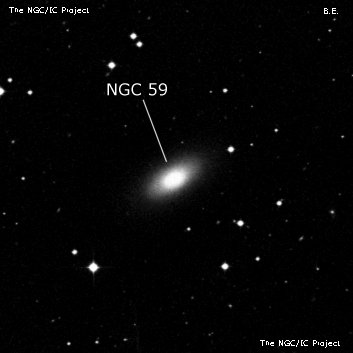NGC/IC Project Restoration Effort
(This is a very very beta version)
NGC59


Basic Information
Location and Magnitude
Right Ascension: 0:15:25.3
Declination: -21:26:41
Constellation: CET
Visual Magnitude: 12.4
Historic Information
Discoverer: Stone
Year of discovery: 1885
Discovery aperture: 26.3
Observational
Summary description: vF, pS, iR, gbM
Sub-type: E-S0
Corwin's Notes
=====
NGC 59 is one of the nebulae found by Ormond Stone with the 26-inch refractor
at the Leander McCormick Observatory in the mid-1880s. While most of the
positions for these first nebulae found at LM are pretty poor, we have in this
case (and about 190 others) a sketch to confirm the object in its surrounding
star field. In addition, Stone has written the discovery date on the sketch
cover sheet: November 10.4 1885.
Bob Erdmann was curious about that "10.4": Was that really the date -- and
time -- of the discovery? That set me to pondering, and this is what I
eventually sent to Bob.
The ".4" is indeed 4/10 of a day, or 9h 36m. I do not know if this is UT or
local time, though. But I suspose we could work it out: I don't think they
observed the thing at 9:36 in the morning, and since L-M is 6hr behind
Greenwich, that would make local time at 10.4 UT something like 10.15 or
3:15+-AM local, which sort of makes sense for an observation of an object at
RA = 0h 10m, -22d 03m (1890) in November. We can check that: Let's see ...
on November 10, N59 crosses the meridian at about 3+ hours before midnight,
so its hour angle at 3:15AM local time is about 3h25m which puts it pretty
deep into the southwestern sky. Assuming they did not have a right-angle
prism on the 26-inch, that would make for pretty comfortable observing,
which at that time on a cool, fall night would be important.
The LM observers wrote the RA and Dec on the cover sheets, too, providing an
additional check on the identities. Finally, they gave us the page number and
"book" number, probably an observing or log book, along with the power at
which they observed the object. In this case, the power is 250, as it is for
most of the observations. Some of the smaller and fainter nebulae, though,
were observed at magnifications of up to 500.
Steve's Notes
=====
NGC 59
17.5" (8/20/88): fairly faint, fairly small, oval WNW-ESE, large bright core. There are four mag 13-14 stars to the west.



